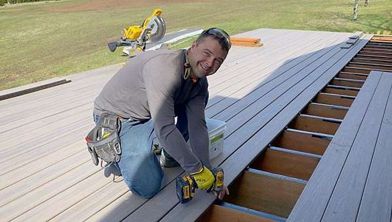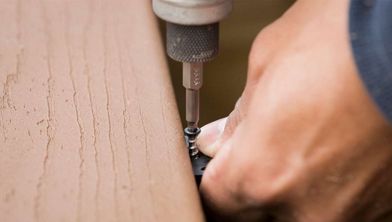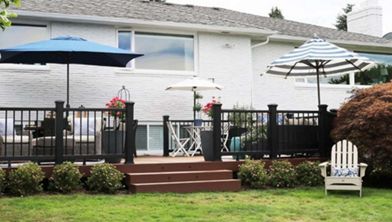Decoding Deck Construction: A Guide to the Anatomy of a Deck
Mastering the Essentials of Deck Design and Construction from the Ground Up
Knowing the general anatomy of a deck is important for anyone interested in building one. While every deck may have its own unique design elements, most share the same fundamental components. Familiarizing yourself with the various deck parts is the first step in understanding the construction process.
A helpful way to visualize the role each decking component plays is by studying a deck framing diagram. By breaking down a deck into individual elements, professionals and DIYers alike can better understand the essential principles of a deck build. Whether building a small, floating platform or an elaborate multi-tiered deck, each structure starts with the same basic foundation.
Set the Foundation: Deck Building Parts that Create the Substructure and Frame
The starting point for any deck is the decking framing or substructure. The substructure provides the foundational support for the entire deck, ensuring its stability and longevity. The deck framing consists of various deck construction parts that work together to distribute the load of the deck – and those it supports – while reinforcing the deck’s structural integrity.
Looking at the above deck framing diagram, you’ll find key elements such as beams, which are the horizontal supports that bear the weight of the deck; joists, which run perpendicular to the beams and provide the foundation for the decking surface; and posts, the vertical supports that transfer the load to the ground. Following is a rundown of the deck building parts that work together to create the underside of a deck.
Footings
Footings play an important role in the substructure of a deck by supporting a deck and distributing its weight effectively. These below-ground concrete bases serve as the anchoring for vertical posts and prevent the deck from sinking or shifting over time. The importance of properly spaced and installed footings cannot be overstated as they bear the brunt of the deck load and significantly impact the structural integrity and safety of a deck.
Support Posts
Support posts are vertical pieces of lumber or metal that attach to the footings via post anchors to hold up the frame of a deck. The placement and spacing of these support posts are integral to the overall design of the deck substructure, requiring careful consideration during the planning and deck construction phase.
Beams
Deck beams, also known as girders, are a part of the deck substructure that supports the joists. Typically positioned parallel to the house, beams bear the load transferred from the joists, distributing it evenly across the support posts. The size and spacing of beams are determined by a deck’s dimensions, local building codes and the decking material used. For extra protection, a self-adhesive butyl tape, like Trex Protect Joist, Beam and Rim Tape, can be applied to the tops of wooden joinery to protect these elements from moisture that can lead to rot, decay and deterioration.
Ledger
Among the most essential parts of a deck frame is the ledger board. This critical support element provides a secure connection between the deck and the house. By securing the deck to an existing structure, the ledger board transfers a significant amount of a deck’s weight to the home’s frame and foundation. Here, too, it's critically important to use flashing to protect the ledger from moisture penetration. Trex Seal Ledger and Sub-Ledger Tapes come in sizes designed to protect the entirety of the ledger board while creating a water-tight seal between the ledger and the housewrap to prevent water from infiltrating the house.
Joists
Joists run perpendicular to a house and create the support structure for the decking surface. These are installed on top of the beams and provide the framework on which the deck boards are installed. The number of joists needed for a deck will vary depending on its size and design. To prevent water from sitting on and penetrating wooden joists, apply flashing tape, like Trex Protect, to the tops of all joists before installing the deck boards.
Blocking
Blocking is essential to the anatomy of a deck. Blocking helps distribute a deck’s load more evenly, reducing bounce and sway in the deck frame. This technique is particularly useful in preventing issues like sagging or unevenness over time, supporting all the components of a deck.
Hardware
Deck building parts can be extremely specific to each build, but hardware will always be an essential piece of the puzzle. Hardware includes items such as joist hangers, fasteners, post anchors, screws and bolts. Supporting a deck with hardware secures the deck substructure and aims to prevent issues like movement, deterioration or deck failure.
Flashing
To reduce the risk of rot and decay, deck parts should be protected from water and moisture with deck flashing. Made of waterproof or water-resistant materials, deck flashing creates a barrier to prevent moisture from seeping into the openings created when attaching the ledger board. There are also specialized flashing tapes available for use on the tops of joists, beams and rims to prevent moisture penetration that can lead to corrosion and wood decay.
Deck Surface: The Deck Parts You Walk On and Use
The deck surface is the most visible aspect of deck construction. This is the functional area of the deck that supports everything that happens on it, from foot traffic to furniture. For DIYers, selecting the right material and other deck construction parts, such as railing, stairs and lighting, will be essential to the planning and design process. After all, these are the deck building parts that will come together to create a stylish and functional outdoor space.
Stairs
The anatomy of a deck goes beyond the surface. For decks with any sort of elevation, you’ll need to factor in steps or stairs for access and safety. Whether a step or two is needed or a full flight of stairs, the stair design will be influenced by the deck height and shape. If space is limited or you’re just looking to add something different, spiral stairs can be an efficient – and fun – addition.
Decking
One of the most prominent deck building parts is the decking itself. This element creates the deck surface and sets the stage for an outdoor space. When evaluating options, be sure to consider product quality, durability, ease of installation, maintenance and sustainability, in addition to aesthetics. Composite decking is an increasingly popular choice for today's homeowners due to its natural-looking aesthetics, durability, low maintenance and sustainability. High-performance Trex composite decking, for instance, is made from a blend of up to 95% recycled and reclaimed content and capped with a proprietary shell that resists fading, staining and scratching. And, unlike wood, composite decking won't rot, warp or crack and they never need to be sanded, sealed or refinished.
Composite decking is offered in variety of profiles from solid to scalloped or honeycomb. Solid boards offer the greatest durability, stability and design flexibility. In many cases, solid boards can be bent using a special heat-bending machine to create curved decks elements. Scalloped and honeycomb boards are lighter weight making them appealing to DIYers. They also tend to be less expensive than their solid board counterparts.
Composite deck boards also come with two basic types of edges - grooved or squared. Grooved boards accommodate concealed or hidden fasteners to deliver a clean, hardware-free surface without any visible screws or nails. Square-edge boards have straight edges and are typically used for perimeter framing or stair treads where a finished edge is desired.
Railing Posts (also known as a guardrail post)
Railing posts not only serve as anchors for the deck’s railing system but enhance safety benefits, making them indispensable for a secure deck. Similar to other components of a deck, the railing posts contribute to the stability and integrity of a deck.
Railing posts can also contribute to the style of a deck thanks to the wide array of post skirts, sleeves and caps available to today's homeowners.
- Post Skirt: A decorative trim piece that conceals the base of a railing post where it meets the deck surface, providing a finished and polished look.
- Post Sleeve: This protective covering slides over a wooden structural post in a deck railing system to shield the post from moisture and add a cohesive design aesthetic.
Post Caps: This decorative element covers the top of the posts, providing a finished look and protecting the ends of the structural railing posts from moisture and damage. Caps are available in a variety of colors and styles, including LED and solar-powered options that illuminate to enhance ambiance and security.
Railing
Providing a protective barrier along the edges of a deck structure, railings are essential – and in many municipalities mandated – for decks with any sort of elevation to prevent accidental falls. Check your local building codes to confirm any railing requirements in your area.
In addition to enhancing safety, railings also are among the most visible aspects of a deck, making them a major design element as well. While wood remains a classic choice for deck railings, it requires regular maintenance to prevent rot, warping and fading. For a more on-trend look with less hassle, consider metal, composite, PVC or glass. With the array of options available today, it's easy to find a material that aligns with virtually any aesthetic preference or budget.
In addition to the railing posts and accessories mentioned earlier, other core components of a railing system include:
- Top Rail: This horizontal component – also called the handrail – sits on top of the railing system providing stability while also making a style statement. Top rails come in a variety of styles from traditional crown top to more contemporary, minimalist designs. Cocktail or drink rail is a popular option among homeowners who like to entertain. This application uses a deck board as a top rail to create a flat surface ledge at just the right height for holding drinks and plates.
- Bottom Rail: The horizontal piece that runs along the bottom of a railing system to hold balusters or infill in place and provide structural support and stability to the entire assembly.
- Balusters: Also referred to as spindles, balusters are the vertical components between the top and bottom rails that provide support and prevent small objects, pets and children from slipping through.
Infill: These design alternatives to traditional balusters often come in panels and are offered in a range of styles from horizonal rods and cables to decorative mesh and glass.
Fasteners
Fasteners pull all the deck construction parts together – literally. These are the screws, clips and plugs used to secure deck boards to the substructure and to one another. To achieve a seamless appearance on a composite deck, consider using hidden fasteners for the field of your deck. Designed to install discreetly between deck boards (as opposed to being nailed or face-screwed), these specialized composite fasteners deliver a clean, hardware-free surface.
It is important to note that hidden fasteners should not be used for border boards, breaker boards, or stairs. To maintain a clean look across your entire deck, we recommend using a plug-based system for installing square edge boards.
Deck Add-Ons for a Finished Look: The Deck Parts that Enhance the Beauty of Your Deck
While a deck needs to be structurally sound, you also want it to be the centerpiece of your backyard. Thoughtful add-ons and well-chosen deck parts are the keys to elevating ambiance and making the most of your outdoor space.
Fascia
Fascia offers the perfect finishing touch to a deck. Installed around the border of your deck and stairs, these boards are used to conceal the joists and other components of a deck to create a clean look and elevate a deck’s overall visual appeal.
Railing Capping
A railing cap is the horizontal top part of a railing system also known as the top rail or handrail. This component plays a key role in the anatomy of a deck by providing stability and making a style statement. Options range from traditional crown designs to minimalist industrial styles. A popular capping option among homeowners who like to entertain is drink rail or cocktail rail, which uses a deck board as a top rail to create a flat surface ledge at just the right height for holding drinks and plates.
Deck Lighting and Solar Post Caps
Lighting can be a valuable addition to any deck and should be considered at the outset of planning along with other essential deck parts. Deck lighting seamlessly integrated into decking, stairs and railing can instantly elevate the aesthetics and safety of an outdoor space. For a sustainable, yet stylish solution, solar post caps add ambiance without the electrical bill.
Cladding
Cladding adds contemporary curb appeal to a building’s exterior. It can be applied vertically or horizontally to create a customized look. Composite cladding, such as Trex, seamlessly integrates with other deck parts to deliver a harmonious look.
Cladding also plays a functional role by acting as a rainscreen, providing a protective armor against the elements and shielding the underlying structure from harsh weather conditions. This helps to prevent moisture penetration and subsequent damage to the building material.
Under-Deck Drainage System
For an elevated deck, consider installing an under-deck drainage system during the deck construction process. Using an integrated network of troughs and downspouts, these systems divert water away from a deck to protect the joinery of the substructure and other deck parts from moisture damage and deterioration. With this added protection, the space beneath the deck is kept dry and can be used for storage or as a fully functional outdoor living space complete with furnishings, lighting and appliances.
Lattice
Lattice can be both decorative and functional. Available in a wide variety of materials and styles, this versatile accent can be incorporated into outdoor spaces to enhance privacy or simply add visual interest.
By strategically placing lattice panels around a deck or patio, you can create a sense of seclusion without blocking airflow and natural light. Similarly, when used as deck skirting, lattice conceals the deck parts and other items beneath a deck while allowing for ventilation, which prevents issues like mold and decay.
If you have a green thumb, lattice is ideal for supporting climbing plants and vines. It allows plants to weave through the openings, creating a beautiful and natural vertical garden. Lattice can also be used as partial walls or partitions to define different functional areas of an outdoor space.
Use Trex’s Deck Designer to Design Your Own Deck Plans
Once you’ve familiarized yourself with all the necessary deck parts, Trex makes it simple to design a deck you’ll love, all from the comfort of home. Our Trex® AR Deck Visualizer is a perfect starting point. This free app allows you to virtually “build” a deck against your actual backyard space using basic deck shapes and colors to help you visualize how different design choices will look in your own home environment.
Then, bring your deck vision to life using the Trex® Deck Design Tool, a user-friendly, online deck planner that lets you design your deck in more detail with 3-D software. When you’ve finished your design, you can obtain a blueprint to share with your contractor or local permitting office, download a shopping list of the materials needed to build your deck, and even show off your custom creation on social media.
This content was partially or fully generated by AI and has been reviewed by our team to ensure accuracy and relevance.







































